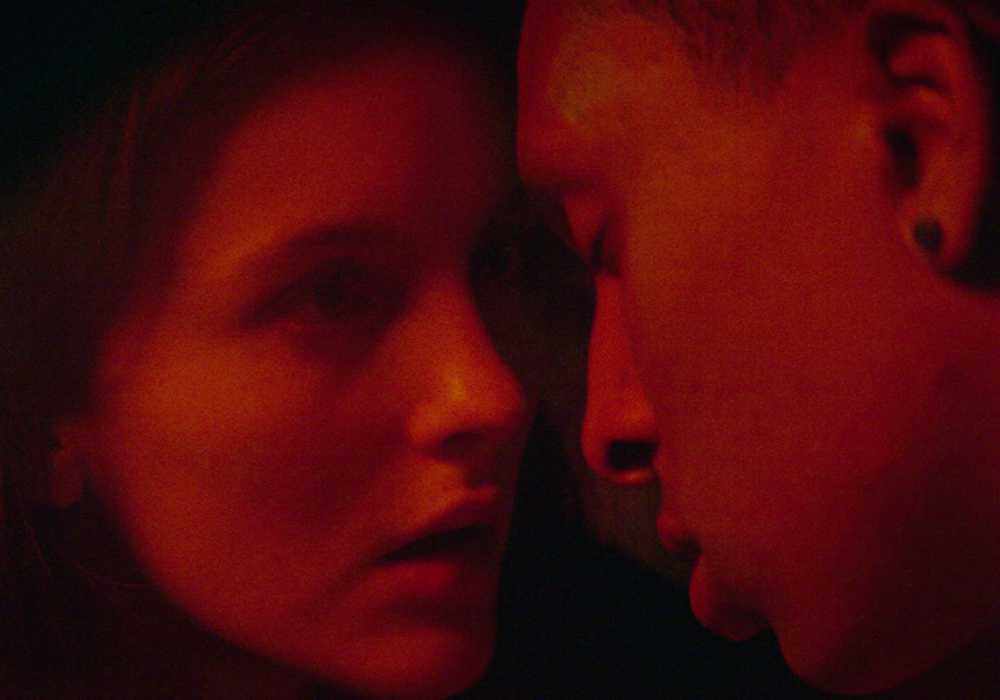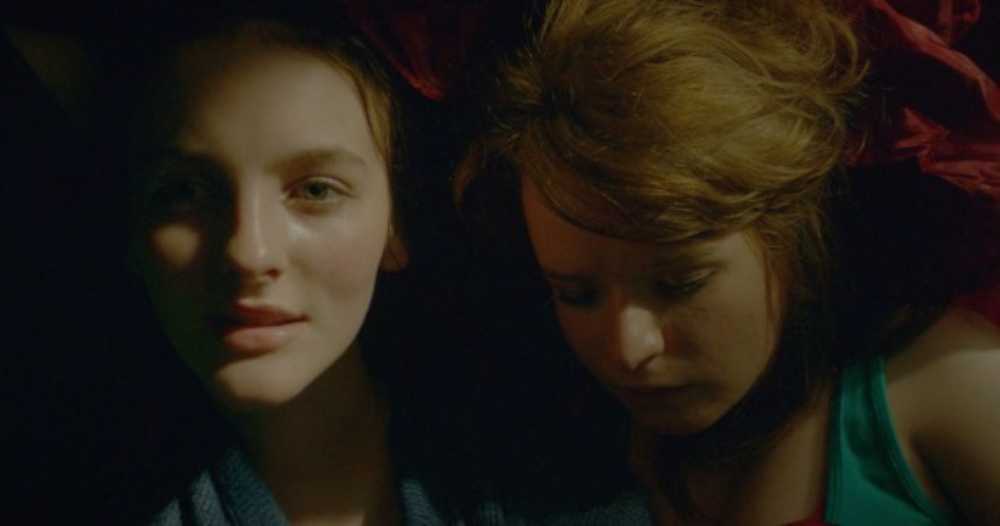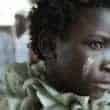Music video director Aoife McArdle discusses her narrative feature debut, Kissing Candice, which marks her as a bold new visual stylist.

Aoife McArdle’s Kissing Candice portrays young womanhood as a disorienting, often frightening experience. Coming from the world of music videos, the Irish director crafts a sensory feast far from the social realist style that the film’s rural setting might suggest. With a heady, immersive aesthetic, this impressive feature debut stands out from standard teen dramas.
Candice (Ann Skelly) is a 17-year-old whose dreams about a boy quite literally merge with reality when he suddenly appears in her waking life. Named Jacob (Ryan Lincoln), the boy at first seems like the imagined creation of a girl driven by lust and loneliness — until the film eventually grants us moments alone with him, outside of Candice’s gaze. McArdle forces us to question Candice’s reliability by giving us time with several supporting characters: Jacob, a group of local boys, Candice’s best friend, Martha (Caitriona Ennis)… How much of what we’re seeing exists for them, too, and how much is just in Candice’s head?
From Candice’s point of view, the world doesn’t always make logical sense, yet her potent emotional life carries us through the film. McArdle’s bold visual filmmaking, combined with Skelly’s magnetic performance, draw us into Candice’s rich interior world; vivid colours thrust us into the mind of a teenage girl who is burning with desire and surrounded by the threat of violence. In Candice’s dreams, a foggy haze distances and beautifies those feelings — but in the real world, colours are lurid, surrounding and trapping her like a deer caught in the headlights.
At the Glasgow Film Festival, I talked to McArdle about making the leap from music video directing to narrative feature filmmaking, creating the aesthetic of dreams vs. reality, the influence of horror cinema on her film, and depicting female friendship on screen.
Seventh Row (7R): What was the genesis of Kissing Candice?
Aoife McArdle: I had always wanted to write an Irish youth film that felt different — vivid, anarchic, and immersive… almost a dark fairy tale, where the place, its history and atmosphere, was as much of a character as its residents. I based the story around dark stories I had grown up around. Candice and Martha evolved out of personal recollections and observations of characters I know intimately.
7R: What did you find challenging about making the transition from music videos to narrative features? How did you have to adapt your approach for Kissing Candice?
Aoife McArdle: Visual storytelling and camera choreography are big passions of mine. All my videos have been scripted narratives where I work very closely with the actors. So, truthfully, I didn’t adapt my approach.
I think the major difference is just the magnitude of a feature. You’re working over a much more sustained, intensive period. In my case, I had so many more actors to work and rehearse closely with. I get very obsessive over performance and the visual detail of every frame in all my work, so obviously, with a feature, I had thousands more frames to obsess over. It was certainly a lot more of an exhausting process.
When I write, I play each scene out in my head. I see how and where I want the camera to move, what the actor is feeling and doing, what the lighting is like, what meaningful colours and art direction I’d like to use. In a way, once I’ve written it, I feel like I’ve already made it. The most taxing thing is trying to ensure that what you’re then creating with your actors and crew is marrying up to this ideal vision you have played out in your mind a thousand times.
[clickToTweet tweet=”‘What I love about great horror is how psychologically immersive, sensory, and experiential it can be. You feel everything the lead character feels, deeply.'” quote=”‘What I love about great horror is how psychologically immersive, sensory, and experiential it can be. You feel everything the lead character feels, deeply.'”]
7R: How did you develop the differentiation between the visual and aural landscapes of dreams and real life?
Aoife McArdle: I’d been exploring these themes tentatively through short form projects for a while. I wanted the dream world to be heady and expansive, revolving around vivid red lighting and the rich, visceral colours you find in nature. Married to that would be eerie, atmospheric soundscapes. All the hues and sounds had to feel very deep and immersive.
Over the previous year, I gathered a huge collection of references, concept art, and storyboards to convey and build the vision of both worlds. The camera choreography in the dream world is sweeping, balletic, and darkly romantic. For reality, conversely, the cinematography is often a lot more still or visually stifling, and the world is quieter, to represent the characters’ perspectives on their real lives. They feel trapped.

7R: Kissing Candice has vivid colours, especially deep reds, is often shot in a disorienting way, and culminates on Halloween, with characters wearing costumes like wolf masks. Was horror an inspiration for you? How did you work to develop that aesthetic influence into a drama?
Aoife McArdle: I think a lot of my inspiration has come from painting, photography, southern gothic fiction, and horror. I took inspiration from fairy tales and mythology, too, but yes, I’m a huge admirer of certain horror and noir aesthetics — 70s and 80s work by Argento, Cronenberg, Friedkin, and Carpenter, right back to vintage Hammer horror and German expressionist films.
What I love about great horror is how psychologically immersive, sensory, and experiential it can be. You feel everything the lead character feels, deeply. I wanted this film to give the audience similar heightened thrills, mostly just to allow them to experience the subjective intensity, danger, and melodrama of being a teenager. It’s a feverish time where the world feels confusing, overwhelming, and constantly in flux. I felt that the tropes of horror cinema helped to convey that.
I love filmmaking that has psychological depth. When I was writing the film, I wrote it more like a novel than a script because I had so much detail in my head relating to the visual and sonic landscape of it. All that detail felt integral to the storytelling and creation of the young people’s world as an imposing character itself.
[clickToTweet tweet=”‘I wanted to allow the audience to experience the subjective intensity, danger, and melodrama of being a teenager.'” quote=”‘I wanted to allow the audience to experience the subjective intensity, danger, and melodrama of being a teenager.'”]
7R: Your lead actress, Ann Skelly, is a really striking presence. She has to carry the entire film. What went into casting her and working with her to develop the character?
Aoife McArdle: I’d been living with the character of Candice for such a long time, and I didn’t want to veer away from the character I’d scripted, so it demanded a long search. I met and auditioned so many girls, but Ann just stayed in my head. There were certain aspects of Candice’s character that she nailed straight away. Other aspects, like Candice’s tomboyish toughness, we worked hard on in rehearsals.
There are a couple of lines of improv in the driving lesson scene, which were important to convey some authentic chemistry between her and Jacob, but everything else is scripted. Having a couple of weeks of intensive rehearsal with the main actors was essential for me so I could convey [my] vision for the characters quietly and respectfully. I knew I was only going to get one or two takes on set, as our shooting schedule was so tight. It was invaluable to relate the vision for each character and work through problems before we got to set.
[clickToTweet tweet=”‘The way their conversations play out in one take, or in a still, calm way, conveys their friendship as a kind of safe place. That’s very personal to me.'” quote=”‘The way their conversations play out in one take, or in a still, calm way, conveys their friendship as a kind of safe place. That’s very personal to me.'”]
7R: My favourite scenes were those between Candice and her best friend, Martha. In a very visually frenetic film, a lot of their conversations take place in single, static, unbroken takes that almost allow us to take a breath. Their back and forth is very natural and comfortable. How did you work to develop that relationship between the two actors?
Aoife McArdle: Writing their sequences was so enjoyable to me, perhaps because I’ve been lucky enough to have some inspiring, close female relationships in my life, via my sister and friends. I wrote those scenes very quickly, and then it was just about making sure the two girls had the chemistry with one another to reflect that authentic intimacy.
It was wonderful to see Ann and Caitriona [Ennis] bring these characters to life so vividly. They drew on their own real-life friendships in their delivery, too. To me, the way their conversations play out in one take, or in a still, calm way, conveys their friendship as a kind of safe place — solace from the maelstrom of the outside world. That’s very personal to me.
McArdle strays from the realist norms of many coming-of-age films with her bold aesthetics, which are complemented by other creative takes on teenage life: Léa Mysius’ astonishing debut feature, Ava, is just as visually bold, immersing you in its protagonist’s subjectivity. We also talked to the directors of Girls Lost and Beach Rats about foraying into genre and stylised filmmaking to explore teenage life and gender expectations.

